
Akamai's Content Delivery Network (CDN)
Discover the intricacies of Akamai's Content Delivery Network (CDN) and its key components. Learn about the widespread server distribution, importance of configuration management, and how Akamai serves a significant portion of web traffic globally.
Download Presentation

Please find below an Image/Link to download the presentation.
The content on the website is provided AS IS for your information and personal use only. It may not be sold, licensed, or shared on other websites without obtaining consent from the author. If you encounter any issues during the download, it is possible that the publisher has removed the file from their server.
You are allowed to download the files provided on this website for personal or commercial use, subject to the condition that they are used lawfully. All files are the property of their respective owners.
The content on the website is provided AS IS for your information and personal use only. It may not be sold, licensed, or shared on other websites without obtaining consent from the author.
E N D
Presentation Transcript
CS4730 Distributed Systems The Akamai Configuration Management System (ACMS) Revised 10/15/18
Required reading for this topic 2 ACMS: The Akamai Configuration Management System Alex Sherman, Phil Lisiecki, Andy Berkheimer, and Joel Wein. Proceedings of NSDI 2005. Boston, MA, May 2005 Experience with some Principles for Building an Internet-Scale Reliable System Mike Afergan, Joel Wein, and Amy LaMeyer. Proceedings of Second Workshop on Real, Large Distributed Systems (WORLDS) '05, San Francisco, CA, December 2005. ACMS
What is a CDN? 3 Content Delivery Network Also sometimes called Content Distribution Network At least half of the world s bits are delivered by a CDN Probably closer to 70/80% Primary Goals Create replicas of content throughout the Internet Ensure that replicas are always available Direct clients to replicas that should give good performance
Key Components of a CDN 4 Distributed servers Usually located inside of other ISPs Often located in Internet Exchange Points (IXPs) High-speed network connecting them Clients (eyeballs) Can be located anywhere in the world They want fast Internet [Web|download|video|audio| ] performance Glue Something that binds clients to nearby replica servers
Background 5 Akamai operates a CDN of ~365,000 servers distributed across 1300+ networks,135+ countries, and every continent ~25% of all web traffic Akamai s customers (web origins, edge computing, ) use these servers to bring their web content and applications closer to the end-users
6 Akamai Configuration Management System (ACMS) Following material leverages presentations by Alex Sherman, Phil Lisiecki, Andy Berkheimer, Joel Wein, and Brian Cho
Problems: Configuration and Control 7 Even with the widely distributed platform customers need to maintain the control of how their content is served DRM, Geofencing, Differentiated content based on ISP, Customers need to configure their service options with the same ease and flexibility as if it was a centralized, locally hosted system Read, write, delete with strong consistency
Problems: Configuration and Control cont. 8 Customer profiles include hundreds of parameters. For example: Cache TTLs Allow lists Whether and what cookies are accepted Whether and what data on application sessions are stored In addition, internal Akamai services require dynamic reconfigurations (mapping, load-balancing, provisioning services) reflecting the dynamism of the Internet
Why is this difficult? 9 300,000 widely dispersed servers must synchronize to the latest configurations within a few minutes Configuration update may be initiated from anywhere on the network and must reach all other servers Some servers may be down or partitioned-off at the time of reconfiguration A server that comes up after some downtime must re-synchronize quickly Do not want to deliver old data Strong Consistency
ACMS Assumptions 11 Configuration files may vary in size from a few hundred bytes to 100MB Submissions may originate from anywhere on the Internet Most updates must be distributed to every Akamai node There is no particular arrival pattern of submissions The Akamai CDN will continue to grow Submissions could originate from a number of distinct applications running at distinct locations on the Akamai CDN Each submission of a configuration file foo completely overwrites the earlier submitted version of foo For each configuration file there is either a single writer or multiple idempotent (non-competing) writers
ACMS System Requirements 12 High availability system must be up 24x7 and accessible from various points on the network Fault-tolerant persistent storage of configuration files for asynchronous delivery Efficient and Scalable delivery configuration files must be delivered to the live edge servers quickly Recovery edge servers must recover quickly Consistency for a given configuration file the system must synchronize to a latest version Security configuration files must be authenticated and encrypted
ACMS Architecture: Two Subsystems 13 Front-end a small collection of Storage Points Responsible for accepting, storing, and synchronizing configuration files Back-End reliable and efficient delivery of configuration files to all the edge servers Leverages the Akamai CDN
Front-end architecture 14 Publisher transmits a file to a storage point Storage Points store, synchronize, and upload the new file on local web servers 300K Edge servers download the new file from the SPs via the CDN
Front-end fault tolerance 15 Mitigate distributed communication failures Implement agreement protocol on top of replication Vector exchange (VE): a quorum based agreement scheme No dependence on a single Storage Point Eliminate dependence on any given network SPs hosted by distinct ISP
Quorum Requirement 16 Define a quorum as a majority (e.g. 3 out of 5 SPs) A quorum of SPs must agree on a submission Every future majority overlaps with the earlier majority that agreed on a file If there is no quorum of alive and communicating SPs, pending agreements halt until a quorum is reestablished
Accepting a file 17 A publisher contacts an accepting SP The accepting SP replicates a temporary file to a majority of SPs If replication succeeds the accepting SP initiates an agreement algorithm called Vector Exchange (VE) Upon success the accepting SP accepts and all SPs upload the new file
Vector Exchange (based on vector clocks) 18 For each agreement SPs exchange a bit vector. Each bit corresponds to commitment status of a corresponding SP. Once a majority of bits are set agreement takes place When any SP learns of an agreement it can upload the submission
Vector Exchange: an example 19 A initiates and broadcasts a vector: A:1 B:0 C:0 D:0 E:0 C sets its own bit and rebroadcasts: A:1 B:0 C:1 D:0 E:0 D sets its bit and rebroadcasts: A:1 B:0 C:1 D:1 E:0 Any SP learns of the agreement when it sees a majority of bits set.
Vector Exchange Guarantees 20 If a submission is accepted, at least a majority have stored and agreed on the submission The agreement is never lost by a future quorum. Q: Why? A: Any future quorum contains at least one SP that saw an initiated agreement. VE borrows ideas from Paxos, BFS [Castro, Liskov] Weaker, cannot implement a state machine with VE VE offers simplicity, flexibility
Recovery Routine 22 The recovery protocol is called Index Merging SPs continuously run the background recovery protocol with one another The downloadable configuration files are represented on the SPs in the form of an index tree The SPs merge their index trees to pick up any missed updates from one another The Edge Servers also need to sync up state
The Index Tree 23 A Snapshot is a hierarchical index structure that describes latest versions of all accepted files Each SP updates its own snapshot when it learns of a quorum agreement For full recovery each SP needs only to merge in a snapshot from majority-1 other SPs Snapshots are also used by the edge servers to detect changes
Back-end: Delivery 25 Processes on edge servers subscribe to specific configurations via a local Receiver process The Receiver periodically checks for updates to the subscription tree by making HTTP IMS requests recursively If the updates match any subscriptions the Receivers download the files
Back-end: Delivery contd 26 Delivery is accelerated via the CDN Local Akamai caches Hierarchical download Optimized overlay routing Delivery scales with the growth of the CDN Akamai caches use a short TTL (on the order of 30 seconds) for the configuration files
Operational Experience: safeguards 27 To prevent CDN-wide outages due to a corrupted configuration, files are zoned A zone is a set of edge servers. All edge servers are in distinct zone Initially, publish a file to a limited set of edge servers, e.g., zone 1 If the system processes the file successfully, publish to zone 2, etc Receivers failover from CDN to SPs Recovery = backup for VE Useful in building state on a fresh SP

